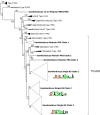Transcriptomic analysis of polyketide synthases in a highly ciguatoxic dinoflagellate, Gambierdiscus polynesiensis and low toxicity Gambierdiscus pacificus, from French Polynesia
- PMID: 32294110
- PMCID: PMC7159223
- DOI: 10.1371/journal.pone.0231400
Transcriptomic analysis of polyketide synthases in a highly ciguatoxic dinoflagellate, Gambierdiscus polynesiensis and low toxicity Gambierdiscus pacificus, from French Polynesia
Abstract
Marine dinoflagellates produce a diversity of polyketide toxins that are accumulated in marine food webs and are responsible for a variety of seafood poisonings. Reef-associated dinoflagellates of the genus Gambierdiscus produce toxins responsible for ciguatera poisoning (CP), which causes over 50,000 cases of illness annually worldwide. The biosynthetic machinery for dinoflagellate polyketides remains poorly understood. Recent transcriptomic and genomic sequencing projects have revealed the presence of Type I modular polyketide synthases in dinoflagellates, as well as a plethora of single domain transcripts with Type I sequence homology. The current transcriptome analysis compares polyketide synthase (PKS) gene transcripts expressed in two species of Gambierdiscus from French Polynesia: a highly toxic ciguatoxin producer, G. polynesiensis, versus a non-ciguatoxic species G. pacificus, each assembled from approximately 180 million Illumina 125 nt reads using Trinity, and compares their PKS content with previously published data from other Gambierdiscus species and more distantly related dinoflagellates. Both modular and single-domain PKS transcripts were present. Single domain β-ketoacyl synthase (KS) transcripts were highly amplified in both species (98 in G. polynesiensis, 99 in G. pacificus), with smaller numbers of standalone acyl transferase (AT), ketoacyl reductase (KR), dehydratase (DH), enoyl reductase (ER), and thioesterase (TE) domains. G. polynesiensis expressed both a larger number of multidomain PKSs, and larger numbers of modules per transcript, than the non-ciguatoxic G. pacificus. The largest PKS transcript in G. polynesiensis encoded a 10,516 aa, 7 module protein, predicted to synthesize part of the polyether backbone. Transcripts and gene models representing portions of this PKS are present in other species, suggesting that its function may be performed in those species by multiple interacting proteins. This study contributes to the building consensus that dinoflagellates utilize a combination of Type I modular and single domain PKS proteins, in an as yet undefined manner, to synthesize polyketides.
Conflict of interest statement
The authors have declared that no competing interests exist.
Figures



Similar articles
-
Role of Modular Polyketide Synthases in the Production of Polyether Ladder Compounds in Ciguatoxin-Producing Gambierdiscus polynesiensis and G. excentricus (Dinophyceae).J Eukaryot Microbiol. 2017 Sep;64(5):691-706. doi: 10.1111/jeu.12405. Epub 2017 Mar 23. J Eukaryot Microbiol. 2017. PMID: 28211202
-
Both modular and single-domain Type I polyketide synthases are expressed in the brevetoxin-producing dinoflagellate, Karenia brevis (Dinophyceae).J Phycol. 2017 Dec;53(6):1325-1339. doi: 10.1111/jpy.12586. Epub 2017 Nov 3. J Phycol. 2017. PMID: 28949419 Free PMC article.
-
Multifunctional polyketide synthase genes identified by genomic survey of the symbiotic dinoflagellate, Symbiodinium minutum.BMC Genomics. 2015 Nov 14;16:941. doi: 10.1186/s12864-015-2195-8. BMC Genomics. 2015. PMID: 26573520 Free PMC article.
-
Ciguatera poisoning in French Polynesia: A review of the distribution and toxicity of Gambierdiscus spp., and related impacts on food web components and human health.Harmful Algae. 2023 Nov;129:102525. doi: 10.1016/j.hal.2023.102525. Epub 2023 Oct 12. Harmful Algae. 2023. PMID: 37951623 Review.
-
Iterative polyketide biosynthesis by modular polyketide synthases in bacteria.Appl Microbiol Biotechnol. 2016 Jan;100(2):541-57. doi: 10.1007/s00253-015-7093-0. Epub 2015 Nov 9. Appl Microbiol Biotechnol. 2016. PMID: 26549236 Free PMC article. Review.
Cited by
-
Insights into Alexandrium minutum Nutrient Acquisition, Metabolism and Saxitoxin Biosynthesis through Comprehensive Transcriptome Survey.Biology (Basel). 2021 Aug 25;10(9):826. doi: 10.3390/biology10090826. Biology (Basel). 2021. PMID: 34571703 Free PMC article.
-
Giant polyketide synthase enzymes biosynthesize a giant marine polyether biotoxin.bioRxiv [Preprint]. 2024 Jan 31:2024.01.29.577497. doi: 10.1101/2024.01.29.577497. bioRxiv. 2024. Update in: Science. 2024 Aug 9;385(6709):671-678. doi: 10.1126/science.ado3290. PMID: 38352448 Free PMC article. Updated. Preprint.
-
Gambierdiscus and Its Associated Toxins: A Minireview.Toxins (Basel). 2022 Jul 14;14(7):485. doi: 10.3390/toxins14070485. Toxins (Basel). 2022. PMID: 35878223 Free PMC article. Review.
-
A Global Approach to Estimating the Abundance and Duplication of Polyketide Synthase Domains in Dinoflagellates.Evol Bioinform Online. 2021 Jul 14;17:11769343211031871. doi: 10.1177/11769343211031871. eCollection 2021. Evol Bioinform Online. 2021. PMID: 34345159 Free PMC article.
-
Genomic insights into the cellular specialization of predation in raptorial protists.BMC Biol. 2024 May 7;22(1):107. doi: 10.1186/s12915-024-01904-2. BMC Biol. 2024. PMID: 38715037 Free PMC article.
References
-
- Dickey RW and Plakas SM. Ciguatera: a public health perspective. Toxicon 2010;56: 126–136. - PubMed
-
- Pearn JH. Chronic Ciguatera. Journal of Chronic Fatigue Syndrome 1996;2: 29–34.
-
- Parsons ML, Aligizaki K, Bottein M-YD., Fraga S, Morton S, Penna A, et al. Gambierdiscus and Ostreopsis: Reassessment of the state of knowledge of their taxonomy, geography, ecophysiology, and toxicology. Harmful Algae 2012;14: 107–129.
Publication types
MeSH terms
Substances
LinkOut - more resources
Full Text Sources
Research Materials
Miscellaneous

